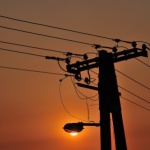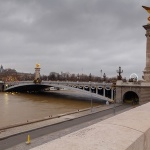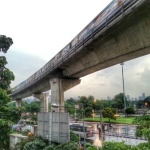 Check out The Contemporary Eruv: Eruvin In Modern Metropolitan Areas written by Rabbi Yosef Gavriel Bechhofer.
Check out The Contemporary Eruv: Eruvin In Modern Metropolitan Areas written by Rabbi Yosef Gavriel Bechhofer.
How an Urban Eruv is Built
A certain Posek once took my chevrusa and me on a field trip around the eruv of an urban community. He began by taking us to a specific street marked on the eruv map as the border of the eruv and offering us $10.00 if we were successful at identifying the lines of the eruv. Needless to say, we did not earn those $10.00!
It might come as a shock to anyone who has erected a private backyard eruv to realize that building a communal eruv usually entails little installation of wire. For the most part, resourceful eruv committees spend weeks and months identifying preexisting structures to serve as part of the communal enclosure. Such structures often are actual walls: fences, embankments, riverbanks, sides of buildings, etc., but overwhelmingly consist of overhead cable belonging to the electric or telephone utility companies. As a result of the expediency of using these preexisting structures – stemming either from concern over funds or over municipal regulations – urban eruvin often follow what seem to be illogical patterns, separating sidewalks from streets, cutting through alleys, or encompassing broad areas with few Jews. The use of wall-like structures, as long as they are man-made, poses few problems. It is the use of overhead cable which causes most of the problems encountered in contemporary urban eruvin.
The Tzuras Hapesach
The Torah forbids us to carry in any area defined as a reshus harabbim (a public domain) on Shabbos. Chazal extended this prohibition to include any unenclosed area. The most popular method of enclosing an area al pi halacha is a tzuras hapesach (literally: “the form of a doorway” – the familiar two poles with a wire across the top and the variations on that theme). The rationale of this solution is that a door frame is a halachically valid form of enclosure (Eruvin 11b). Eruvin of this sort enclose areas as small as a back yard and as large as entire neighborhoods.
The most basic halacha of tzuras hapesach which the poles and wire comprise, is that the wire which crosses over the poles (the “lechayayim”) must pass over the top of the poles, not on or over the sides of the pole. Crossing over the side of the pole constitutes the psul of tzuras hapesach min hatzad (“on the side”), explicitly invalidated by the Gemara in Masechta Eruvin ibid. (and Shulchan Aruch, Orach Chaim 362:11) (fig. 1).
This halacha poses a formidable problem when utilizing overhead cable in the construction of an eruv. Although occasionally the cable does in fact go from the top of one pole to the top of the next, more often than not the cable is attached to the side of the pole. Frequently, the same cable will weave back and forth, going from the top of the pole to the side of the next one, out on a crossbar and back again in quick succession!
In Israel, where the municipal authorities are cooperative, the problem of tzuras hapesach min hatzad is usually rectified by placing wide barrels which are at least ten tefachim high underneath the overhead cable. The halachic principle of gud asek mechitzta (“the wall is [halachically] extended higher”) then allows us to draw an imaginary line directly up from the top of the barrel to the cable, allowing us to view the barrel, not the utility pole, as the lechi for the tzuras hapesach (fig. 2).
In Chutz La’Aretz, however, the authorities are not as cooperative, and will usually not allow such obtrusive tikkunim. The usual approach here, therefore, is to bolt a plank, a rod, or tubing to the utility pole to serve as the lechi wherever one is necessary.
Using a Rod as a Lechi
The problem encountered most frequently as a result of the use of a narrow object as lechi is in the application of gud asek. The Chazon Ish (Orach Chaim, Eruvin 71:6) rules that the imaginary line is always drawn straight up, regardless of the angle of the lechi. Many utility poles are warped or bent at an angle, either as a result of carelessness in the original construction, weather conditions over time, or being hit by cars or trucks. The lechayayim attached to such poles bend with them at the same angle – yet gud asek still draws the imaginary line straight up from the top of the lechi (The Chazon Ish also rules that gud asek begins only at the top, not the middle of a pole)(fig. 3). In such a situation the gud asek is meaningless, as the line drawn from the top of the lechi will not hit the overhead cable.
Some Rabbonim will, nonetheless, permit the use of gud asek in the construction of an eruv based on utility poles. In order to prevent the bent pole problem they require the use of a surveyor’s tool or a plumb line in order to determine that the lechi is directly underneath the overhead cable. At best, however, this is a hazardous approach. A single invalid lechi can render an entire eruv invalid. An average sized urban eruv may contain hundreds of lechayayim attached to telephone poles. The surveyor (usually a utility company employee or a hastily trained member of the local eruv committee) must meticulously check every pole – a time consuming, tedious, and sometimes expensive task. Unless one’s yiras shamayim is very strong, diligence tends to erode over time. A further problem is that any pole may become bent over time, necessitating constant surveillance.
Another problem which may arise when gud asek lechayayim are used is that often a utility company box may be attached to the utility pole between the lechi and the overhead cable. If the lechi is built all the way up to the box, or to within three tefachim of it, then the box may be considered part of the lechi (the halachic device of “lavud” allows us to regard objects within three tefachim of each other as connected). If, however the lechi ends more than three tefachim beneath the box, then the box is a hefsek which interrupts the gud asek (Mishna Berura, Orach Chaim 363:112).
Due to all these considerations, “state of the art” eruvin do not utilize gud asek lechayayim, but rather build the lechi all the way up to the overhead cable. In such a case no imaginary line need be drawn, as an actual line goes all the way to the wire. Actual lines may be bent at an angle and remain halachically valid (The lechi itself, however, must be reasonably straight, not pronouncedly crooked or bent. An angle of more than approximately 25 degrees is problematic.) (fig. 4).
The Overhead Cable
The Mishna Berura (Orach Chaim 362:66) cites a disagreement as to whether the cable must be absolutely taut or may sag and/or sway in the wind between the lechayayim (fig. 5). The trend, based on the Aruch HaShulchan and others (Orach Chaim 362:37), is to be lenient – as long as when there is no wind the cable at rest runs due straight from lechi to lechi. As we noted previously, overhead cables often weave back and forth. A typical question which arises concerns the following case (fig. 6): Three utility poles, each consisting of an upright pole and a crossbar across the top, stand in a row. The overhead cable runs directly across the first and third pole in the row, but is connected to the crossbar of the middle pole. In this case, even when at rest, the cable does not run directly from lechi to lechi. The Chazon Ish (Orach Chaim, Eruvin 71:10) considers such a tzuras hapesach definitely invalid. It is worthwhile emphasizing again that one psul can invalidate an entire eruv.
The Position of the Pole
Several problems arise in regard to the position of the utility pole and/or the lechi attached to the pole. Occasionally the path of the utility cables requires the placement of poles on private property. In and of itself such positioning is not a problem; however, often such property is surrounded by a fence which the eruv is thus forced to cross (fig. 9). The Mishna Berura (Orach Chaim 363:113) and others rule that such a situation is invalid. A similar problem applies in a case where a hedge which is larger than the allowed measurements has grown to surround the lechi (fig. 10). The Avnei Nezer (Orach Chaim no. 291), however, tends to be lenient so long as the height of the lechi exceeds the height of the surrounding fence or hedge by at least ten tefachim. The lechi is then regarded as a distinct wall above and beyond the surrounding fence whose significance cannot be nullified by an imaginary gud asek. Other poskim advance somewhat more lenient positions, but even the position of the Avnei Nezer is cited as a heter b’she’as hadechak (“a leniency one may rely uponin a difficult situation”).
Transferring from Fence to Cable
Due to the many problems involved in the use of overhead cable, it is obviously preferable to utilize fences and other such wall-like structures wherever possible. Usually, however it is difficult to rely only on fences. For example, inevitably fences must be interrupted in order to allow streets to pass through. In order to insure that the continuous line of the eruv encompasses the city, the enclosure must travel across the street, either by way of erecting a tzuras hapesach across the street, or, as is often the case, by jumping to an overhead cable which crosses the street. The problem which frequently arises is that the poles are usually behind and not within three tefachim of the fence (fig. 11). This presents the problem: what connects the fence to the overhead cable? The fence is usually unsuitable for use as a lechi (see below), so drawing the gud asek line up from the fence will not help. In the case we have presented here a lechi would have to be placed on the fence directly underneath the overhead cable (thus creating a gud asek).
Elevated Train Lines and Bridges
Rabbi Yehoshua Siegel, commonly known as the Sherpser Rav, first arrived in New York in 1884 and settled on the Lower East Side. The Sherpser Rav was the foremost rabbi of Polish-Chassidic origin in America at the time, and in fact was a rival of Rabbi Jacob Joseph, the Chief Rabbi of New York, who was of Lithuanian extraction. In 1907 the Sherpser Rav published a pamphlet, “Eruv V’Hotza’a”, which allowed the residents of the Lower East Side to carry in the streets on Shabbos. Although the Jews of Lithuanian descent generally did not rely on the Sherpser Rav’s heter (one of the founders of Yeshivas Rabbeinu Yitzchak Elchanan, Rabbi Yehuda David Bernstein, wrote a pamphlet, “Hilchasa Rabasa L’Shabasa”, disputing the heter), people still were carrying on the Lower East Side as late as 1947, when Rabbi Yosef Eliyahu Henkin (Eidus L’Yisrael, p.151) wrote that even the original rationale for the heter in any event no longer applied.
What walls did the Sherpser Rav use in formulating his heter? The Lower East Side was surrounded on three sides by the walls  which front on the East River, and on the fourth side by the Third Avenue elevated train line. An elevated train line looks just like a classic tzuras hapesach: the support beams might be seen as lechayayim and the overhead train tracks might be seen as the lintel. A similar approach is quoted by the She’arim Mitzuyanim B’Halacha (82:9) in the name of the She’eilos U’Teshuvos Even Yekara. The She’arim Mitzuyanim B’Halacha, however, takes issue with the Even Yekara. Just as a doorframe is distinct from the walls and ceiling of the room to which it is affixed, so too the doorframe effect which constitutes a tzuras hapesach requires that the lechayayim and lintel be distinct from the walls of the structure to which they are affixed. The She’arim Mitzuyanim B’Halacha therefore rules that a bridge or overpass may only be regarded as a tzuras hapesach if it has features (such as protruding girders or supports) which may be regarded as distinct from its wall.
which front on the East River, and on the fourth side by the Third Avenue elevated train line. An elevated train line looks just like a classic tzuras hapesach: the support beams might be seen as lechayayim and the overhead train tracks might be seen as the lintel. A similar approach is quoted by the She’arim Mitzuyanim B’Halacha (82:9) in the name of the She’eilos U’Teshuvos Even Yekara. The She’arim Mitzuyanim B’Halacha, however, takes issue with the Even Yekara. Just as a doorframe is distinct from the walls and ceiling of the room to which it is affixed, so too the doorframe effect which constitutes a tzuras hapesach requires that the lechayayim and lintel be distinct from the walls of the structure to which they are affixed. The She’arim Mitzuyanim B’Halacha therefore rules that a bridge or overpass may only be regarded as a tzuras hapesach if it has features (such as protruding girders or supports) which may be regarded as distinct from its wall.
Conclusion
Almost inevitably the construction of an eruv in an urban setting becomes a matter of controversy. Almost as inevitably, the issues involved in the controversy cause much confusion and strife, especially among those not familiar with Hilchos Eruvin. The focus of such controversies usually centers on the halachic definition of a reshus harabbim, i.e., what constitutes a public domain which cannot be enclosed al pi halacha with the device of tzuras hapesach. A common misconception is that once the reshus harabbim question is resolved, the actual construction of the eruv is a relatively simple and straightforward matter. Perhaps our review of – only – a few of the possible issues involved in the construction of an eruv in a metropolitan area dispels that misconception!
Many sources stress the advisability and importance of building eruvin wherever possible (Shemiras Shabbos K’Hilchasa, 17:21; Halachos of the Eruv, “BeMakom Hakdama”). A positive attitude towards eruvin is exhibited by many Poskim. The positive attitude in theory does not, however, always translate into a positive attitude in practice. The reasons for this inconsistency should be clarified, at least somewhat, by our discussions. The nature of Hilchos Eruvin is such that not only must Poskim where well versed in the halakhos be consulted in all cases, but that they also must be brought from on-site inspections of the area and the eruv prior to, during, and after construction. Only in this way can the theoretical positive attitude be translated into practice, and only thus will enhanced Oneg Shabbos not be attained at a cost of diminished Shemiras Shabbos.


